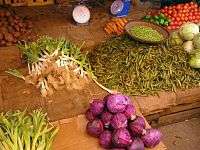Zanzibari cuisine
| Part of a series on the |
| Culture of Tanzania |
|---|
 |
| History |
| People |
| Languages |
| Religion |
|
Music and performing arts |
| Sport |
|
Monuments |
|
Symbols |
|
Zanzibari cuisine reflects several heterogeneous influences, as a consequence of the multi-cultural and multi-ethnic nature of Zanzibar's and Swahili heritage. It is a mixture of various culinary traditions, including Bantu, Arab, Portuguese, Indian, British and even Chinese cuisine.
History

The first inhabitants of Zanzibar were Bantus coming from mainland Tanganyika; they were mostly fishers. Their diet thus consisted of primarily seafood, such as tuna, mackerel, lobster, squid, octopus and oysters. Other ingredients and recipes brought by Bantus that are found in today's Zanzibari cuisine (some of which became widespread during European colonialism) are common beans, sweet potatoes, manioc chips, yam and plaintain.
In the 9th century, Omanis, Yemenis and Persians began colonizing the Swahili Coast, including the Zanzibar Archipelago. They brought along with them new dishes and ingredients, most notably spices, coconut, mango, citrus and rice. One of the most common Zanzibar recipes, the pilau (pilaf) rice (i.e., rice, coconuts, nuts and spices), clearly reflects its Arab origin.
Between the 15th century and the 16th century, the Portuguese quickly conquered most of the African Great Lakes, including Zanzibar. The main Portuguese influences on Zanzibari cuisine was the introduction of those that would become major types of staple food in Zanzibar, namely manioc, maize and pineapple.
In 1651, the Portuguese lost control of Zanzibar to the Omani sultanate. The Omanis brought new spices and intensified the commercial relationships between Zanzibar and India; as a consequence, Indian recipes such as chutney, masala, biryani, curry, fish cakes and samoosa (samosa) made it to Zanzibar. Most recipes of foreign origin were adapted to the ingredients that were available on the island, thus giving birth to a largely original "fusion" cuisine.
Around the beginning of the 20th century most of the African Great Lakes region was colonised by the Germans and the British. Those did not mix with the local population as much as the Arabs, Persians and Indians had done, and their influence on Zanzibari cuisine is less evident; yet, some very common Zanzibari recipes, such as pepper steak, can be generically defined as having an European origin.
After independence, Tanzania established a strong relationship with China; Chinese physicians, engineers, and military consultants came to Zanzibar. Although only a small fraction of today's Zanzibari population has Chinese origins, some recipes and ingredients, such as soy sauce, have become commonplace on the island.
Examples

- Sorpotel
Sorpotel is a recipe of Portuguese-Indian (Goan) origin, consisting of a mixture of boiled meat; in Zanzibar, this includes tongue, heart and liver. It is cooked with masala (a mix of spices similar to curry), as well as tamarind and vinegar.
- Spice cake
The spice cake is the most typical dessert in Zanzibari cuisine. It is made of a pastry with a mix of cinnamon, clove, nutmeg and chocolate.
- Boku-boku
Boku-boku is a sort of skew of meat cooked in maize, ginger, cumin, chili, tomato and onion.
- Date and hazelnut bread
Bread prepared with hazelnuts and dates, as well as eggs and vanilla, is the most traditional food to celebrate the end of Ramadan.
- Pilau meat
Pilau meat is usually prepared with goose (sometimes calf or cow) meat cooked with potatoes, onions, spices, coconut milk and rice.
- Pepper shark
Shark is one of the most traditional types of Zanzibari seafood; it is prepared with pepper and other spices.
- Pweza wa nazi
Pweza wa nazi (meaning "octopus and coconut" in Swahili) is octopus boiled in coconut milk, curry, cinnamon, cardamom, garlic and lime juice.
References
- Zazibari cuisine
- (Italian) l'isola dei buongustai